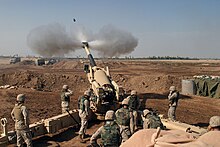Firing position
A firing position in the general sense is a section of terrain in which one or more weapon systems of the artillery , anti- tank or anti-aircraft systems , rocket weapons , mortars or rocket launchers with the associated management and support organs are in position . Since the term firing position also describes the place from which a single one of these weapon systems carries out its fire orders or leads the fire fight, one also speaks of firing positions in connection with the spatial planning for the battle .
structure
Firing positions are generally explored in advance. The firing positions of the artillery are selected, depending on the type of battle, so that approx. One to two thirds of the shooting range extends into the enemy area. In and near the firing position of conventional artillery and mortars, in addition to the weapon systems, there are also the battery officer / chief, the platoon leader, the fire control center, ammunition vehicles, the medical team and the exploratory or judging group. The latter measured the firing position according to position and height , set up the weapon systems and thus contributed to a safe shooting basis . For autonomous weapon systems such as B. the PzH 2000 and the MARS there is no need for measurement or setup. In situation maps a presentation is effected by means of military symbols .
literature
- Colonel W. Speisebecher paperback for artillerymen, 2nd episode , Verlag Wehr und Wissen, 1974, ISBN 3-8033-0231-5
See also
swell
- Army Service Regulations 100/100 Leadership in Combat (TF / G) - classified information only for official use (not public), Bonn 1962, 1974, 1998, (new editions and continuous updates), from 2007 Army Service Regulations 100/100 Troop Leadership of Land Forces
- Army service regulation 100/900: leadership terms
Individual evidence
- ↑ Paperback for artillerymen, pp. 17 and 166

